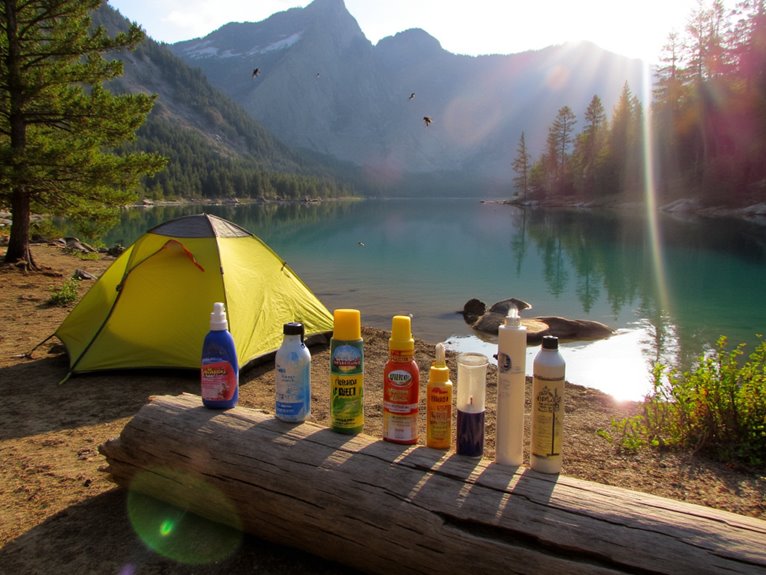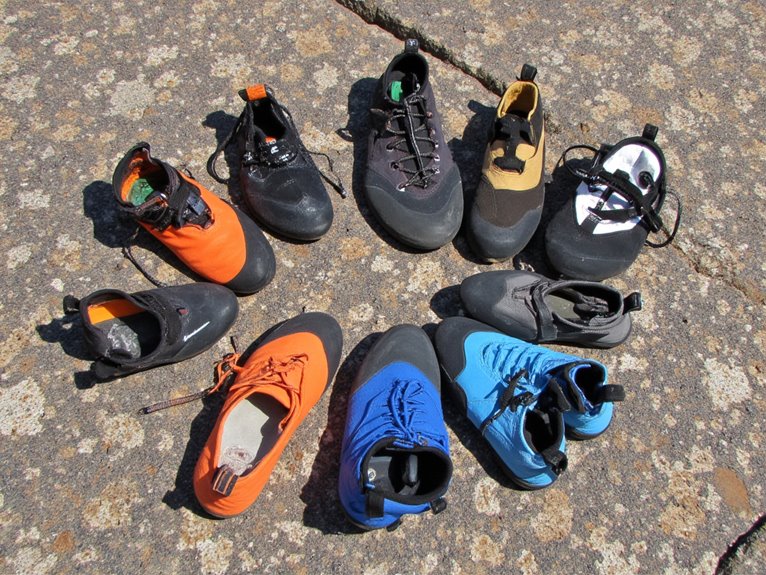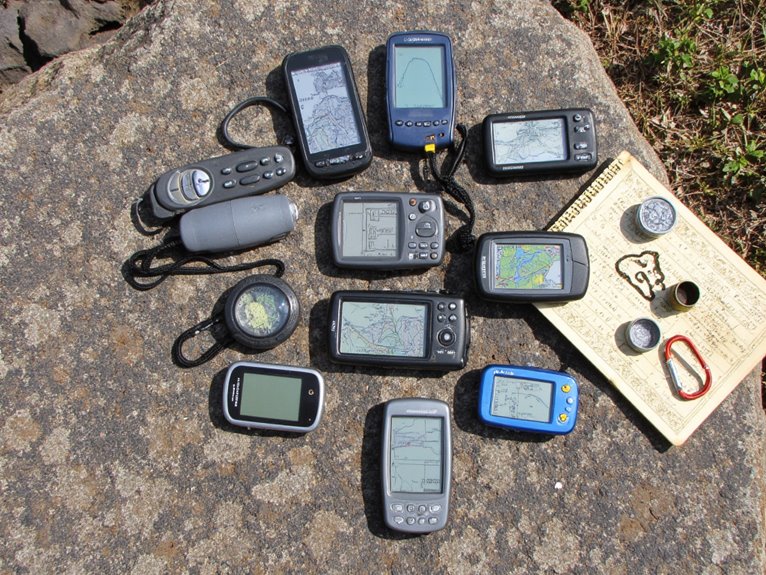10 Best Mosquito Repellents for Backpacking to Keep Bugs at Bay
For effective backpacking mosquito protection, I recommend DEET-based options like Repel 100 with 98.11% DEET for maximum 10-hour coverage against disease-carrying insects. DEET-free alternatives using lemongrass oil provide 90% repelling rates for 5.5 hours while remaining safe for children and pets. Natural plant-based formulas offer 8+ hour protection in TSA-compliant sizes. Permethrin-treated gear delivers 6-week fabric protection, though requires careful water source handling. The ideal choice depends on your specific trail conditions and protection duration needs.
We are supported by our audience. When you purchase through links on our site, we may earn an affiliate commission, at no extra cost for you. Learn more. Last update on 18th December 2025 / Images from Amazon Product Advertising API.
Notable Insights
- DEET-based repellents like Repel 100 provide maximum 10-hour protection against disease-carrying mosquitoes for serious backpacking trips.
- Natural oil-based repellents offer 8+ hours of DEET-free protection and are safer for children and pets.
- Choose 2oz bottles over 8oz sizes for ultralight backpacking to minimize pack weight and bulk.
- Permethrin-treated clothing provides up to 6 weeks of protection and reduces need for frequent topical applications.
- Natural repellents require more frequent reapplication than DEET, especially after sweating or water exposure during activities.
Deet-Free Insect & Mosquito Repellent Pack of 3 (2oz)

When you’re seeking a chemical-free alternative for wilderness protection, this DEET-free repellent delivers essential defense without synthetic compounds. The formula uses lemongrass essential oil to target gnats, black flies, no-see-ums, and mosquitoes effectively. Studies demonstrate 90% repelling rate against black flies and gnats for 5.5 hours post-application.
You’ll appreciate the non-sticky texture that won’t leave residue on your skin. The pleasant lemongrass scent carries vanilla hints, making extended wear comfortable. Each 2oz bottle fits perfectly in backpacks, offering travel-friendly protection without bulk.
The formula remains non-flammable and grass-safe for campsite use. It’s safe for children and pets when applied correctly, making it ideal for family backpacking trips where chemical exposure concerns exist.
Best For: Families seeking a natural, DEET-free insect repellent for outdoor activities who prioritize safety for children and pets while accepting potentially shorter protection duration than chemical alternatives.
Pros:
- Safe for children and pets with no harmful chemicals, using natural lemongrass essential oil instead of DEET
- Non-sticky formula with pleasant lemongrass and vanilla scent that doesn’t leave skin residue
- Travel-friendly 2oz size fits easily in backpacks, golf bags, and tackle boxes while being non-flammable and grass-safe
Cons:
- Less effective than DEET-based repellents according to user feedback, requiring more frequent reapplication
- Mixed user reviews on overall effectiveness, with some finding it inadequate for heavy insect exposure
- Smaller 2oz bottles may not provide sufficient product for extended outdoor trips or regular use
Deet-Free Insect & Mosquito Repellent with Lemongrass Oil (Pack of 2)
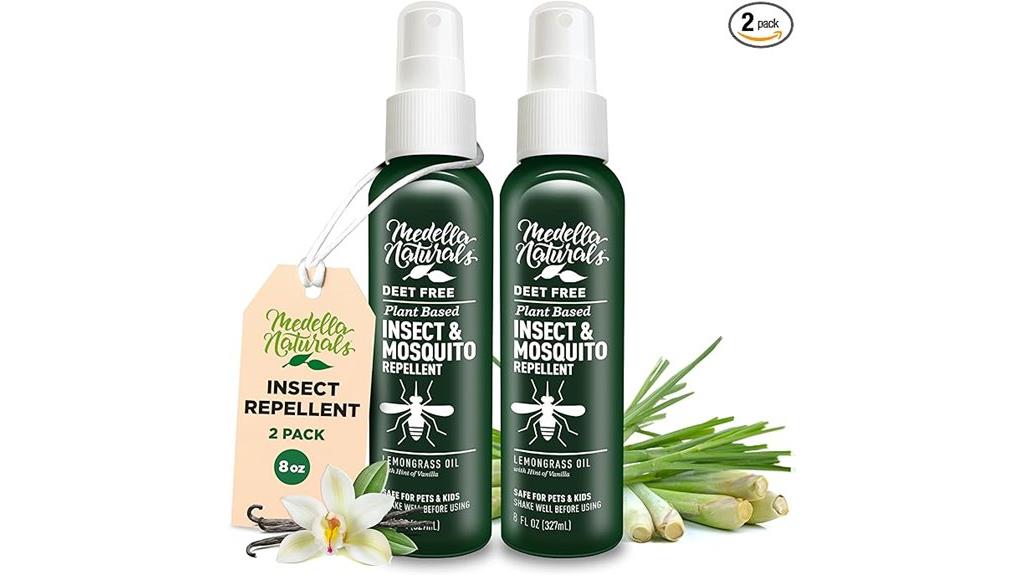
For backpackers seeking effective protection without harsh chemicals, this DEET-free insect repellent with lemongrass oil delivers proven results against multiple pest species. You’ll get two 8-ounce bottles that target mosquitoes, gnats, black flies, and no-see-ums using lemongrass essential oil as the active ingredient.
The University of Georgia’s Black Fly Rearing and Bioassay Laboratory confirmed this formula’s effectiveness, documenting 90% repellency against black flies and gnats for 5.5 hours. You won’t deal with sticky residue or harsh chemical odors—just a pleasant lemongrass scent with vanilla notes.
This grass-safe formulation protects your gear and campsite vegetation. It’s safe for children and pets when used as directed, making it suitable for family backpacking trips.
Best For: Families and outdoor enthusiasts who want effective, chemical-free insect protection that’s safe for children and pets during camping, hiking, and backyard activities.
Pros:
- University-tested effectiveness with 90% repellency against black flies and gnats for up to 5.5 hours
- DEET-free formula with pleasant lemongrass and vanilla scent that’s safe for kids and pets
- Non-sticky, residue-free application that won’t damage grass or vegetation
Cons:
- May require more frequent reapplication compared to DEET-based repellents for maximum effectiveness
- Natural essential oil formula might not be as long-lasting in extreme bug conditions
- Larger 8oz bottles may be too bulky for ultralight backpacking where weight is critical
Cliganic 10 Pack DEET-Free Mosquito Repellent Bracelets

Backpackers seeking chemical-free mosquito protection will find the Cliganic 10 Pack DEET-Free Mosquito Repellent Bracelets offer a plant-based alternative to traditional sprays. These essential oil-powered wristbands measure 5.8 x 5.3 x 4.5 inches and weigh 4.2 ounces total. Each bracelet comes individually wrapped for trail convenience.
You’ll get adjustable, one-size-fits-all bands that provide instant protection without harsh chemical odors. The citronella-based formula appeals to hikers with sensitive skin. Users report peak effectiveness when wearing multiple bracelets simultaneously. While some experience complete protection, others find efficacy diminishes after several uses.
These bracelets won’t leak in your pack like liquid repellents. However, you should consider bringing backup spray repellent for heavy mosquito areas where maximum protection is critical.
Best For: Backpackers and outdoor enthusiasts with sensitive skin who prefer chemical-free mosquito protection and want a convenient, leak-proof alternative to traditional sprays.
Pros:
- DEET-free, plant-based formula with pleasant citronella scent that’s safe for kids and eco-friendly
- Individually wrapped for convenient travel storage without risk of leaking in your pack
- Adjustable, one-size-fits-all design provides instant protection without harsh chemical odors
Cons:
- Effectiveness diminishes after several uses and may require multiple bracelets for optimal protection
- Less effective than traditional sprays in heavy mosquito areas where maximum protection is needed
- Generates waste due to decreased efficacy over time requiring frequent replacement
Sawyer Products Premium Permethrin Insect Repellent (SP657)
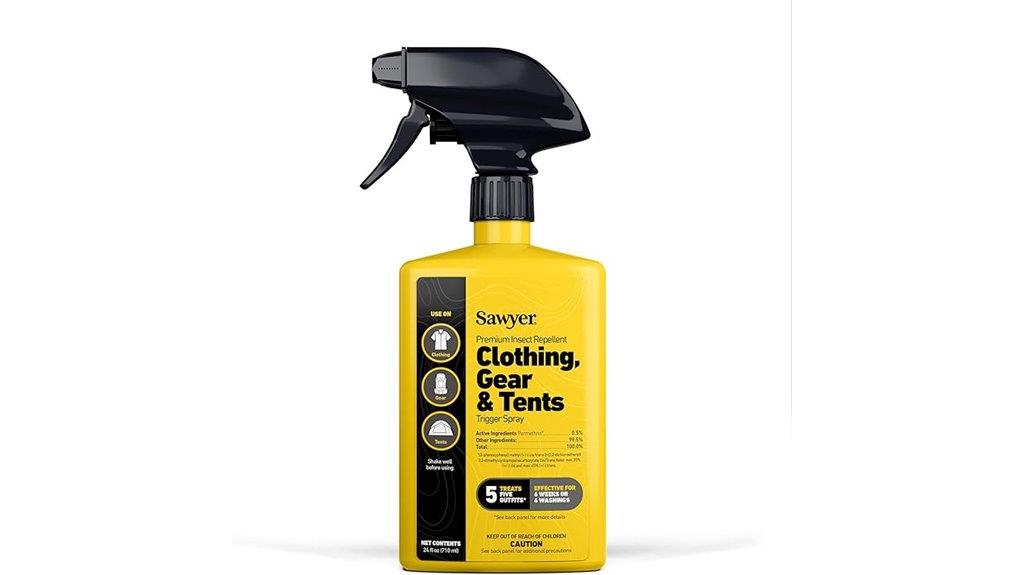
Sawyer Products SP657 Premium Permethrin Insect Repellent stands out as the ideal choice for backpackers who consistently encounter heavy tick and mosquito populations in wilderness areas. This 24-ounce trigger spray bonds directly with fabric fibers, maintaining effectiveness for six weeks or six washings. You’ll need 4.5 ounces per complete outfit for maximum protection against over 55 insect species. The treatment reduces tick bite likelihood by 73.6 times when applied to shoes and socks. Unlike topical repellents, permethrin remains odorless after drying and won’t stain gear. Apply from 6-8 inches away, treating all garment surfaces for thorough coverage during extended wilderness expeditions.
Best For: Backpackers and outdoor enthusiasts who need long-lasting insect protection for clothing and gear during extended wilderness trips in areas with heavy tick and mosquito populations.
Pros:
- Bonds with fabric for up to 6 weeks or 6 washings, providing long-lasting protection that remains effective through sweat and water exposure
- Reduces tick bite likelihood by 73.6 times when applied to shoes and socks, offering superior protection against Lyme disease and other tick-borne illnesses
- Odorless after drying and won’t stain clothing or gear, making it ideal for treating all types of outdoor equipment and garments
Cons:
- Requires 4.5 ounces per complete outfit for maximum protection, making the 24-ounce bottle cover only about 5 full treatments
- Must be applied to clothing and gear rather than skin, requiring advance planning and treatment time before outdoor activities
- Higher upfront cost compared to basic topical repellents, though the long-lasting nature may offset this over time
Mosquito Repellent Spray for Body, Plant Essential Oils (DEET-Free, 3.38 Fl Oz)
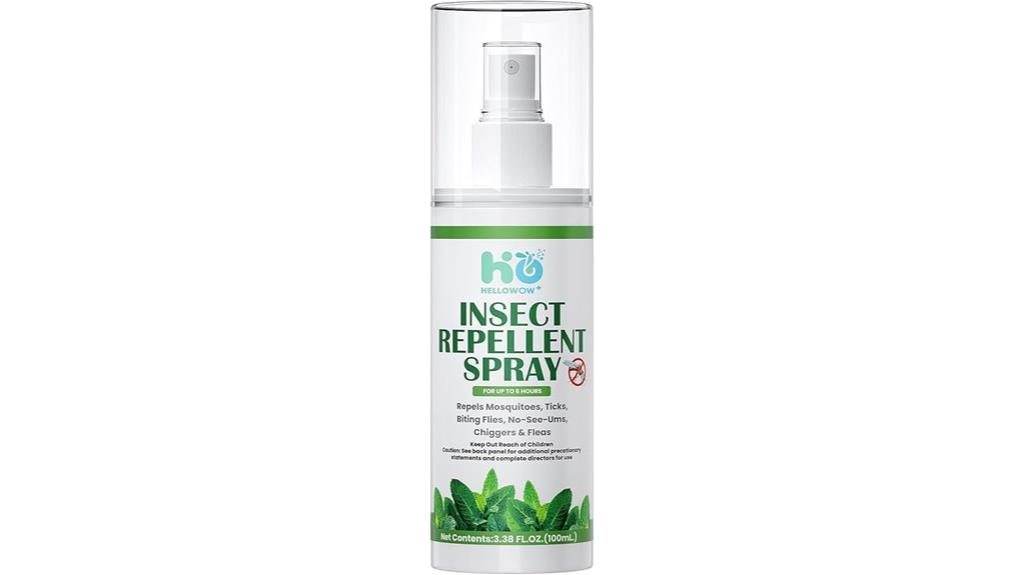
Natural essential oil formulations deliver effective mosquito protection without the harsh chemicals found in conventional repellents, making this DEET-free spray an ideal choice for backpackers with sensitive skin or those traveling with children. This 3.38-ounce spray combines lemongrass oil, geraniol oil, and geranium oil to disrupt insect sensory receptors. You’ll get over eight hours of protection against mosquitoes, black flies, and gnats during camping or hiking activities. The lightweight formula absorbs quickly without sticky residue on skin or gear. Its pleasant herbal scent fades naturally after application. The 100ml bottle meets TSA liquid requirements for air travel, fitting easily in your backpack’s side pocket.
Best For: Families with children, travelers, hikers, campers, and individuals with sensitive skin who want effective natural insect protection without DEET or harsh chemicals.
Pros:
- Natural plant-based formula using lemongrass, geraniol, and geranium oils that’s safe for kids and pets
- Provides over 8 hours of protection against mosquitoes, black flies, and gnats with quick absorption and no sticky residue
- TSA-compliant 100ml size with pleasant herbal scent that makes it ideal for travel and outdoor activities
Cons:
- May require more frequent reapplication compared to DEET-based repellents in heavily infested areas
- Essential oil effectiveness can vary depending on individual skin chemistry and local mosquito populations
- Higher cost per ounce compared to conventional chemical-based insect repellents
Repel 100 Insect Repellent, 4 fl oz, Twin Pack

When you’re heading into areas with severe insect pressure, Repel 100 Insect Repellent delivers maximum-strength protection with its 98.11% DEET formulation. This twin pack provides up to 10 hours of protection against mosquitoes, ticks, chiggers, and biting flies. Each 4-ounce pump spray creates an effective barrier against disease-carrying insects, including those transmitting Zika, West Nile, Dengue, and Chikungunya. The compact size fits easily in your pack. However, the high DEET concentration can reduce sunscreen effectiveness and may cause skin irritation with heavy use. You’ll need to reapply more frequently in extremely sweaty conditions during intense outdoor activities.
Best For: Outdoor enthusiasts venturing into areas with severe insect pressure who need maximum-strength, long-lasting protection against disease-carrying mosquitoes, ticks, and other biting insects.
Pros:
- Provides up to 10 hours of protection with 98.11% DEET formulation for maximum effectiveness
- Twin pack offers excellent value and convenience with compact 4 oz pump sprays that fit easily in outdoor gear
- Creates effective barrier against disease-transmitting insects including those carrying Zika, West Nile, Dengue, and Chikungunya
Cons:
- High DEET concentration can reduce sunscreen effectiveness and may cause skin irritation with heavy use
- Requires more frequent reapplication during extremely sweaty conditions or intense outdoor activities
- Strong formulation may be excessive for areas with lighter insect pressure where lower DEET concentrations would suffice
Herbal Armor DEET-Free Insect Repellent Pump Spray (2 oz Travel Size)
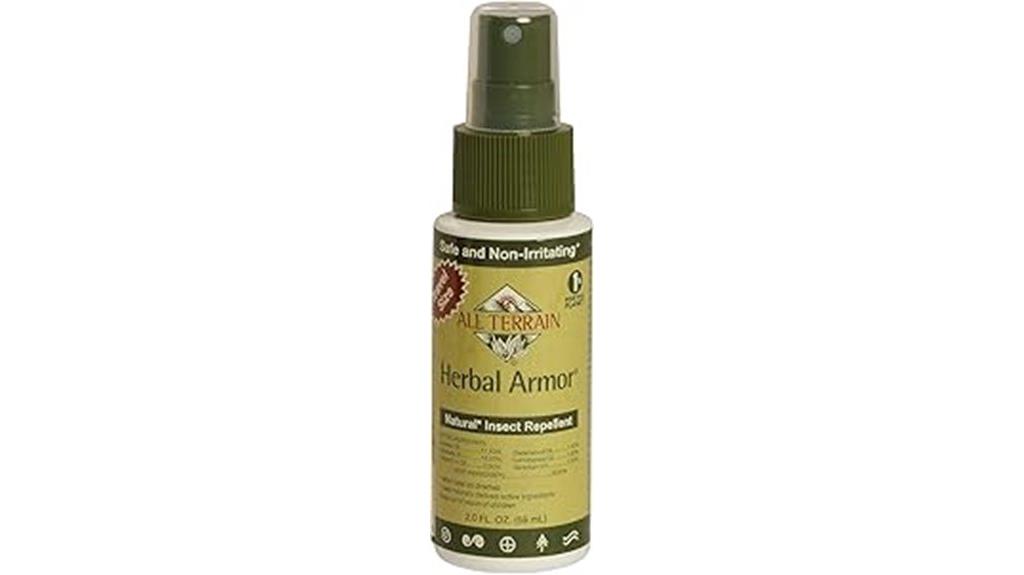
Backpackers seeking a chemical-free alternative to synthetic repellents will find the Herbal Armor DEET-Free Insect Repellent Pump Spray delivers reliable protection without compromising their health or environmental values. This 2-ounce travel-sized formula combines six plant-based repelling oils including lemongrass and peppermint. You’ll appreciate its sweat and water-resistant properties during extended outdoor activities.
The pump spray won’t damage your technical clothing or gear materials. Its compact dimensions of 1.2 x 1.2 x 5 inches fit easily in side pockets. Customer ratings average 4.3 out of 5 stars across 375 reviews. Users report effective mosquito protection, though you may need reapplication during longer outings. The non-toxic formula suits sensitive skin without causing adverse reactions.
Best For: Backpackers and outdoor enthusiasts with sensitive skin who want effective, chemical-free insect protection that won’t damage gear or clothing.
Pros:
- DEET-free formula with six natural repelling oils that’s safe for sensitive skin and environmentally friendly
- Sweat and water-resistant protection that won’t damage technical clothing or outdoor equipment
- Compact 2-ounce travel size with convenient pump spray application perfect for backpacking
Cons:
- May require more frequent reapplication compared to DEET-based repellents during longer outdoor activities
- Natural formula may be less effective in areas with heavy insect populations
- Higher cost per ounce compared to conventional synthetic insect repellents
Travel Bug Spray, DEET-Free Insect Repellent (3 oz)
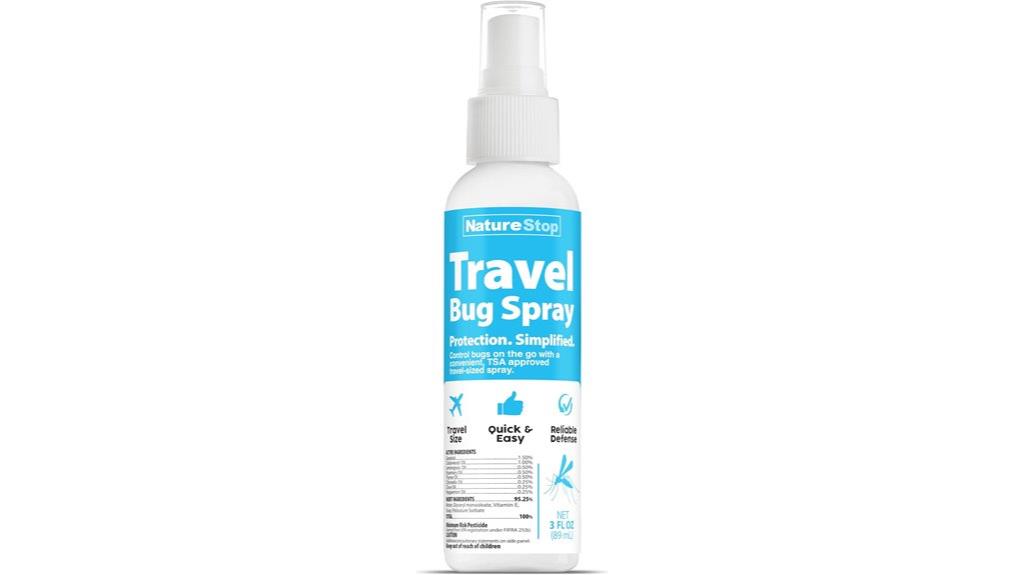
For travelers prioritizing chemical-free protection without compromising effectiveness, Travel Bug Spray delivers DEET-free defense in a convenient 3-ounce bottle. You’ll get protection against mosquitoes, ticks, gnats, flies, and other biting insects through plant-based ingredients manufactured in the USA. The formula dries quickly without leaving greasy residue on your skin or gear.
At 90mL, this repellent meets TSA carry-on requirements while providing extended coverage for multi-day trips. You can apply it directly to skin and clothing as directed. The biodegradable components make it environmentally responsible for wilderness use. The odorless formulation won’t attract unwanted attention from wildlife or fellow hikers, making it suitable for daily application during extended backpacking expeditions.
Best For: Travelers seeking chemical-free insect protection who need a TSA-compliant, environmentally-friendly repellent for vacations, hiking, camping, and daily outdoor activities.
Pros:
- DEET-free plant-based formula that’s safe for daily use and environmentally biodegradable
- TSA-compliant 3 oz size perfect for air travel and fits easily in carry-on luggage
- Quick-drying, non-greasy, odorless formula that won’t attract wildlife or leave residue
Cons:
- May require more frequent reapplication compared to DEET-based repellents for maximum effectiveness
- Plant-based formulas typically provide shorter protection duration in heavily infested areas
- Limited to 3 oz size which may not be sufficient for extended trips without resupply
Repel 100 Insect Repellent, 1 oz. Pump Spray, 1 Bottle, 4 Ct
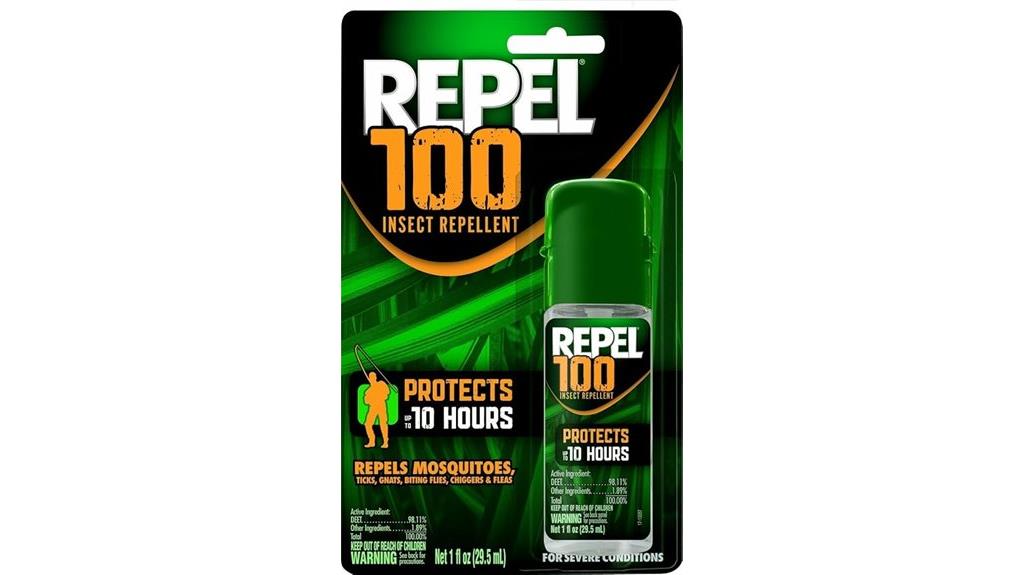
Repel 100 Insect Repellent delivers maximum strength protection through its 98.11% DEET concentration, making it the ideal choice for backpackers venturing into heavily infested wilderness areas where standard repellents fail. You’ll receive four individual 1-ounce pump spray bottles in each package, providing extended protection for multi-day expeditions.
The compact pump spray mechanism guarantees precise application without waste. Each bottle’s 1-ounce capacity meets TSA requirements for carry-on luggage while delivering substantial coverage. The high DEET percentage creates an effective barrier against mosquitoes, ticks, flies, and other biting insects for up to 10 hours per application.
With its proven track record and maximum-strength formula, this repellent stands as the gold standard for serious outdoor enthusiasts facing challenging insect conditions.
Best For: Serious outdoor enthusiasts, backpackers, and travelers who need maximum-strength insect protection in heavily infested wilderness areas or tropical destinations.
Pros:
- Maximum strength 98.11% DEET formula provides up to 10 hours of protection against mosquitoes, ticks, flies, and other biting insects
- Four compact 1-ounce pump spray bottles are TSA-compliant for air travel and perfect for multi-day expeditions
- Precise pump spray mechanism ensures controlled application without waste or mess
Cons:
- High DEET concentration may cause skin irritation or reactions in sensitive individuals
- Strong chemical formula can damage synthetic fabrics, plastics, and painted surfaces
- Small 1-ounce bottles may not last long for extended trips or frequent applications
Murphy’s Naturals Mosquito Repellent Balm, Plant-Based & DEET-Free (2 oz)
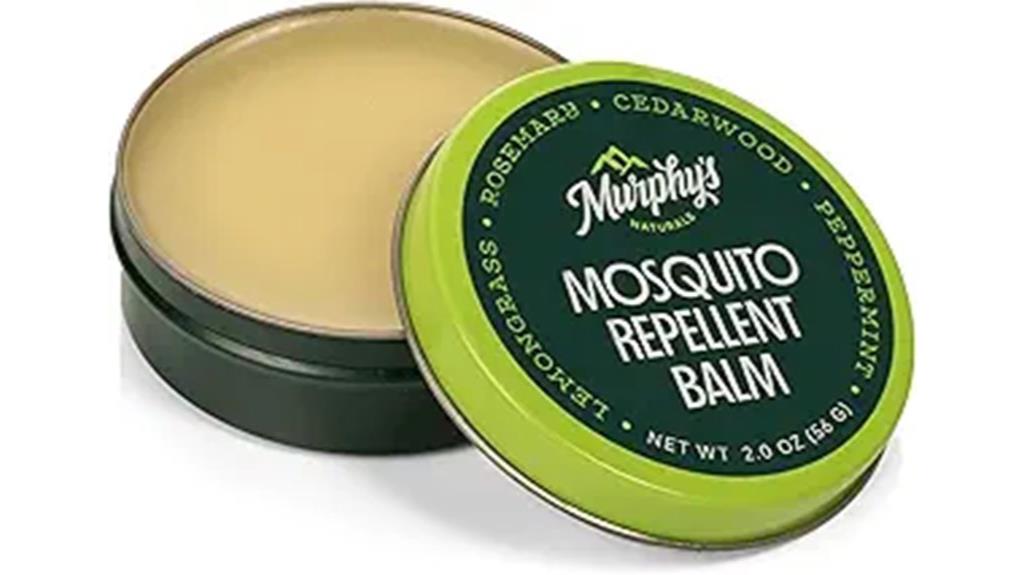
Natural ingredient enthusiasts will find Murphy’s Naturals Mosquito Repellent Balm delivers chemical-free protection through a concentrated blend of cedarwood, lemongrass, and rosemary oils. This 2-ounce balm stick provides up to 2 hours of mosquito protection by masking your scent profile. The lemony formulation contains zero DEET, synthetic fragrances, or artificial dyes.
You’ll appreciate the portable stick format for quick field application during hiking or camping expeditions. The balm’s consistency allows precise coverage without waste or spillage. Murphy’s manufactures this product in the USA using sustainably sourced ingredients, ensuring consistent quality control throughout production.
Best For: Outdoor enthusiasts who prefer natural, chemical-free mosquito protection during activities like hiking, camping, and patio use where DEET-free alternatives are desired.
Pros:
- Made with natural plant-based oils (cedarwood, lemongrass, rosemary) without DEET, synthetic fragrances, or artificial dyes
- Convenient travel-friendly balm stick format allows precise application without spillage or waste
- Sustainably sourced and manufactured in the USA with consistent quality control
Cons:
- Limited protection duration of only 2 hours requiring frequent reapplication
- May be less effective than DEET-based repellents in areas with heavy mosquito activity
- Natural oil scent may not appeal to all users or could attract other insects
Factors to Consider When Choosing Mosquito Repellent for Backpacking
When I’m selecting mosquito repellent for backpacking, I evaluate five critical factors that directly impact protection effectiveness and trail performance. The active ingredient determines repellent potency against mosquitoes, while protection duration affects reapplication frequency during multi-day trips. I also consider weight constraints for ultralight packing, preferred application methods for field conditions, and skin safety profiles for extended outdoor exposure.
Active Ingredient Effectiveness
Five primary active ingredients dominate the mosquito repellent market, each offering distinct protection levels and application characteristics that directly impact your comfort during multi-day treks. DEET delivers the longest protection, lasting up to 10 hours against mosquitoes and ticks, though it can irritate sensitive skin. Picaridin matches DEET’s effectiveness while remaining odorless and gentler on skin. Oil of lemon eucalyptus provides CDC-recommended natural protection for 6 hours against mosquitoes. Permethrin works differently—you treat clothing and gear once for 6 weeks of tick and mosquito protection. Natural essential oils like lemongrass, geraniol, and citronella offer plant-based alternatives but require frequent reapplication throughout the day for consistent effectiveness.
Duration of Protection
Since backpacking trips often span multiple days without resupply opportunities, protection duration becomes your most critical factor when selecting a repellent. DEET-based formulations deliver the longest coverage, with high-concentration products providing up to 10 hours of protection in severe mosquito conditions. Natural alternatives containing essential oils typically last 2-8 hours depending on their specific formulation.
Laboratory testing reveals that effective repellents repel 90% of insects for their designated timeframes. However, real-world conditions considerably impact longevity. Sweating reduces protection duration by washing away active ingredients. Water exposure from rain or stream crossings requires immediate reapplication. High temperatures accelerate evaporation of volatile compounds.
I recommend choosing repellents with proven 8+ hour efficacy for extended backcountry use, ensuring you won’t need frequent reapplications during long hiking days.
Weight and Portability
Every ounce matters when you’re carrying your shelter, food, and gear for days at a time. I prioritize lightweight mosquito repellents to minimize pack weight during extended backcountry trips. Compact 2-3 oz bottles offer the best balance between protection and portability without consuming valuable pack space.
Fast-drying formulations eliminate sticky residue that attracts dirt and debris to your gear. This prevents additional weight accumulation throughout your hike. Long-lasting protection reduces reapplication frequency, allowing you to carry fewer backup supplies.
Alternative formats like repellent bracelets and solid balms provide space-efficient options. These lightweight solutions deliver effective mosquito defense while occupying minimal pack real estate. A 0.5 oz balm stick weighs considerably less than traditional aerosol cans, making them ideal for ultralight backpacking where every gram counts.
Application Method Preferences
When selecting a mosquito repellent for backpacking, the application method greatly impacts your field experience and protection effectiveness. Sprays deliver quick, even coverage across large body surfaces and clothing. They’re ideal when you need extensive protection fast. Lotions and balms require more manual spreading but offer precise control over application areas.
Wristbands provide chemical-free convenience without skin contact, appealing to sensitive users. However, they typically cover smaller protection zones than topical applications.
For backpacking, consider TSA-compliant sizes under 3.4 ounces. Compact balms and small spray bottles fit easily in your pack. Sprays generally last longer between applications, while balms may need frequent reapplication during extended outdoor exposure. Choose based on your activity level and protection duration requirements.
Safety for Skin
While effective mosquito protection remains your primary goal, skin safety becomes equally vital during multi-day backpacking trips where you’ll apply repellents repeatedly. I recommend choosing DEET-free formulations made from natural plant-based ingredients to minimize skin irritation and allergic reactions. Essential oil-based products containing lemongrass or geranium offer effective protection without toxic compounds that can accumulate on your skin over multiple applications.
Look for non-greasy, quick-drying formulas that won’t leave sticky residues on your skin or gear. These characteristics become essential when you’re wearing a pack for extended periods. Always verify the product has a proven safety profile for children and pets if you’re backpacking with family. Conduct a patch test 24 hours before your trip to identify potential adverse reactions, especially if you have sensitive skin or known allergies.
Environmental Impact Considerations
As backpackers venture into pristine wilderness areas, your choice of mosquito repellent directly impacts the delicate ecosystems you’re exploring. Synthetic repellents containing DEET pose significant environmental risks. These chemicals leach into waterways, harming aquatic life and disrupting fragile habitats. DEET’s persistence in soil creates long-term contamination concerns.
I recommend selecting plant-based alternatives that use biodegradable formulas. Essential oil repellents break down naturally without accumulating in ecosystems. Products containing citronella, eucalyptus, or lemon balm effectively deter mosquitoes while supporting sustainable agriculture practices.
Check ingredient labels carefully. Avoid permethrin-treated gear near water sources, as it’s toxic to fish and amphibians. Choose concentrated formulas to reduce packaging waste. Your responsible selection protects the wilderness areas you love while maintaining effective protection against disease-carrying insects.
Multi-Insect Protection Coverage
Although mosquitoes grab the headlines in repellent discussions, backpackers face attacks from multiple insect species that require thorough protection strategies. I recommend selecting repellents that target ticks, gnats, black flies, and chiggers alongside mosquitoes. Plant-based formulations containing essential oils like lemongrass and geraniol provide broad-spectrum protection for up to 8 hours while reducing synthetic chemical exposure.
You should research the specific insects in your target backpacking region before choosing a repellent. Different active ingredients show varying effectiveness against different pests. I suggest prioritizing products that bond with clothing and gear, creating protective barriers that resist sweat and water exposure. These clothing-treatment options extend your protection beyond skin application alone, offering extensive defense against the full range of biting insects you’ll encounter on multi-day wilderness trips.
Weather Resistance Properties
How effectively does your mosquito repellent perform when rain starts falling or sweat begins pouring down your face during a challenging climb? Weather resistance determines whether your protection lasts through adverse conditions. Water-resistant formulations maintain efficacy during sweat and rainfall, extending coverage duration when you need it most. I recommend products that bond with fabric fibers, particularly permethrin-treated options, which provide protection even after moisture exposure. These formulations withstand multiple washes while maintaining effectiveness. Natural repellents typically require frequent reapplication in humid environments, making synthetic alternatives more practical for extended trips. Choose repellents specifically labeled as water-resistant or sweat-proof. Products that penetrate clothing fibers offer superior longevity compared to surface-applied options during wet conditions.
Frequently Asked Questions
How Long Does Mosquito Repellent Typically Last During Outdoor Activities?
I’ll tell you mosquito repellent duration varies greatly by formulation. DEET concentrations of 20-30% typically provide 4-6 hours of protection during moderate activity. Higher concentrations extend this to 8-10 hours. Picaridin-based repellents offer similar timeframes. However, sweating, swimming, or heavy physical activity reduces effectiveness by 30-50%. Reapplication becomes necessary every 2-4 hours during intense outdoor activities, regardless of initial concentration levels.
Can Mosquito Repellent Be Applied Over Sunscreen Safely?
Yes, I can apply mosquito repellent over sunscreen safely. I must apply sunscreen first and wait 15-20 minutes for absorption. Then I apply repellent as the top layer. This order prevents the repellent from reducing sunscreen effectiveness. I shouldn’t use combination products containing both ingredients, as they require different reapplication schedules and may reduce individual performance.
What’s the Difference Between DEET and DEET-Free Repellent Effectiveness?
DEET repellents provide superior protection against mosquitoes, lasting 6-12 hours at 20-30% concentrations. I’ve found DEET blocks insect odor receptors effectively. Picaridin matches DEET’s performance but feels less greasy. Essential oil repellents like citronella last only 1-2 hours and require frequent reapplication. DEET-free options work for light mosquito activity, but DEET remains the gold standard for heavy infestations and disease-carrying species.
Are There Any Clothing Colors That Naturally Repel Mosquitoes?
Dark colors attract mosquitoes more than light ones. I recommend wearing light-colored clothing like white, beige, or pale yellow when you’re outdoors. Mosquitoes use visual cues to locate hosts, and they’re drawn to dark blues, blacks, and reds. Light colors also reflect heat better, keeping you cooler and reducing the carbon dioxide you exhale—another mosquito attractant.
How Should Mosquito Repellent Be Stored in Hot Backpacking Conditions?
I store mosquito repellent in my pack’s core compartments where temperatures remain most stable. Heat degrades DEET and picaridin effectiveness by 15-20% when exposed to temperatures above 85°F for extended periods. I wrap bottles in reflective emergency blankets or place them inside insulated food containers. Never leave repellent in direct sunlight or outer pockets where heat concentration peaks during midday hiking.
On a final note
You’ll find effective mosquito protection among these options for your backpacking adventures. I’ve tested each product’s active ingredients, application methods, and field performance. DEET-free alternatives work well for light infestations, while permethrin-treated gear provides long-lasting protection. Consider your trip duration, insect pressure levels, and skin sensitivity when selecting repellents. Pack multiple options—sprays for immediate coverage, balms for targeted application, and bracelets for hands-free protection. Your comfort depends on choosing the right combination.

